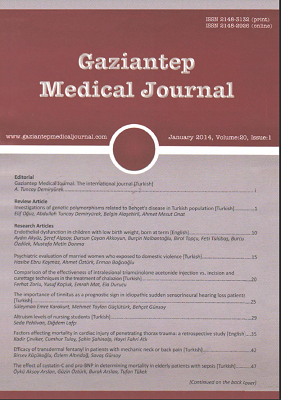Anti-retroviral therapy adherence and its determinants among adult patients living with HIV/AIDS in South West Ethiopia: a facility-based cross sectional study
Güney Batı Etiyopya’da HİV/AİDS’le yaşayan yetişkin hastalar arasında antiretroviral tedaviye uyma ve bunun belirleyicileri: olanak-tabanlı çapraz kesitli bir çalışma
DOI:
https://doi.org/10.5455/GMJ-30-43192Keywords:
Adherence, antiretroviral therapy, Ethiopia, prevalenceAbstract
Adherence to anti-retroviral therapy (ART) regimen is essential for successful treatment and sustained viral control. Optimal adherence is the compliance to ART that achieves a sustained plasma drug concentration that suppresses viral replication. The objective of this study is to assess ART adherence and its determinants at Agaro Health Center ART Clinic, South Western Ethiopia. Facility-based cross sectional study was conducted from June 9-29, 2011. Patients were interviewed to collect adherence related information by using pretested semi-structured questionnaire. Subsequent charts of prescribed medications were reviewed using a pretested data collection format. A total of 209 respondents were included in the study, of which 127 (60.8%) were females and 82 (39.2%) were males. The average adherence rate was 98.1% among males and 99.5% among females. The overall average adherence rate among the respondents was 98.8%. One hundred sixty one (77.0%) respondents had a 100% adherence rate, 15 (7.2%) patients had a 93.3% adherence rate and the remaining 33 (15.8%) patients had adherence rate between 95 and 98% on average. The common reasons for missing of the prescribed doses were forgetting 27 (39.7%), being too busy 20 (29.4%), away from home 17 (25.0%) and being extremely ill 4 (5.9%). Of all the variables, sex, living alone, monthly income, use of stimulants and medications in addition to ART were significantly associated with non-adherence. The adherence rate among the study participants was found to be optimal, and near perfect adherence need to be maintained to obtain the optimum therapeutic outcome.
Metrics
References
UNAIDS/WHO: AIDS epidemic update 2007. Geneva, Switzerland, 2007. http://data.unaids.org/pub/epislides/2007/2007_epiupdate_en.pdf (Accessed on 20 November 2013)
Irunde H, Ngemera M. A Study on adherence to antiretroviral therapy in Tanzania a Pre-intervention study, Dare-salaaam, Tanzania. Tanzanian Food and Drug Authority Research, 2004; 5-26. http://archives.who.int/prduc2004/FinalProposalARVAdherenceStudyTanzania.pdf (Accessed on 20 November 2013)
Kunutsor S, Walley J, Katabira E, Muchuro S, Balidawa H, Namagala E, et al. Clinic Attendance for Medication Refills and Medication Adherence amongst an Antiretroviral Treatment Cohort in Uganda: A Prospective Study. AIDS Res Treat 2010;2010:872396.
Altice FL, Friedland GH. The era of adherence to HIV therapy. Ann Intern Med 1998;129(6):503-5.
Mannheimer S, Friedland G, Matts J, Child C, Chesney M. The consistency of adherence to antiretroviral therapy predicts biologic outcomes for human immunodeficiency virusinfected persons in clinical trials. Clin Infect Dis. 2002;34(8):1115-21.
Drug Administration and Control Authority (DACA). Standard treatment guideline for primary hospitals. Addis Ababa, Ethiopia. Drug Administration and Control Authority of Ethiopia Contents, 2010; 4-41. http://apps.who.int/medicinedocs/documents/s17820en/s17820en.pdf (Accessed on 20 November 2013)
Erah PO, Arute JE. Adherence of HIV/AIDS patients to antiretroviral therapy in a tertiary health facility in Benin city. Afr J Pharm Pharmacol 2008;2(7):145-52.
Kumarasamy N, Safren SA, Raminani SR, Pickard R, James R, Krishnan AK, et al. Barriers and facilitators to antiretroviral medication adherence among patients with HIV in Chennai, India: a qualitative study. AIDS Patient Care STDS 2005; 19(8):526-37.
Rougemont M, Stoll BE, Elia N, Ngang P. Antiretroviral treatment adherence and its determinants in Sub-Saharan Africa: a prospective study at Yaounde Central Hospital, Cameroon. AIDS Res Ther 2009;6:21.
World Health organization (WHO), Adherence to long-term therapies. Evidence for action. Geneva. 2003;17-21. http://whqlibdoc.who.int/publications/2003/9241545992.pdf (Accessed on 20 November 2013)
Summary and statistical report of the 2007 population and housing census. Population size by age and sex. United Nations Population Fund (UNFPA), Addis Ababa, Ethiopia; 2008. http://www.scribd.com/doc/28289334/Summaryand-Statistical-Report-of-the-2007 (Accessed on 20 November 2013)
Beyene KA, Gedif T, Gebre-Mariam T, Engidawork E. Highly active antiretroviral therapy adherence and its determinants in selected hospitals from south and central Ethiopia. Pharmacoepidemiol Drug Saf 2009;18(11):1007-15.
Potchoo Y, Tchamdja K, Balogou A, Pitche VP, Guissou IP, Kassang EK. Knowledge and adherence to antiretroviral therapy among adult people living with HIV/AIDS treated in the health care centers of the association "Espoir Vie Togo" in Togo, West Africa. BMC Clin Pharmacol 2010;10:11.
Nyambura A. Factors that influence non–adherence to antiretroviral therapy (ART) among human immunodeficiency virus and acquired immune deficiency syndrome (HIV/ AIDS) patients in Kenya, Kenyatta University, Kenya. Department Of Public Health, 2009;68-71.
Tiyou A, Belachew T, Alemseged F, Biadgilign S. Predictors of adherence to antiretroviral therapy among people living with HIV/AIDS in resource-limited setting of southwest Ethiopia. AIDS Res Ther 2010;7:39.
Tadios Y. Antiretroviral treatment adherence and its correlates among people living with HIV/AIDS on highly active antiretroviral therapy, Addis Ababa, Ethiopia. Research paper, 2005; 57-62. http://etd.aau.edu.et/dspace/bitstream/123456789/2728/1/YONAS%20TADIOS%2c.pdf (Accessed on 20 November 2013)
Amberbir A, Woldemichael K, Getachew S, Girma B, Deribe K. Predictors of adherence to antiretroviral therapy among HIV-infected persons: a prospective study in Southwest Ethiopia. BMC Public Health 2008;8:265.
Orrell C, Bangsberg DR, Badri M, Wood R. Adherence is not a barrier to successful antiretroviral therapy in South Africa. AIDS 2003;17(9):1369-75.
Downloads
Published
How to Cite
Issue
Section
License
Copyright (c) 2023 European Journal of Therapeutics

This work is licensed under a Creative Commons Attribution-NonCommercial 4.0 International License.
The content of this journal is licensed under a Creative Commons Attribution-NonCommercial 4.0 International License.


















